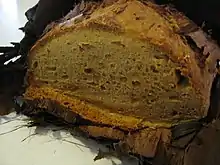 A modern damper | |
| Type | Unleavened bread (traditionally) |
|---|---|
| Place of origin | Australia |
| Created by | Stockmen |
| Main ingredients | Wheat flour, salt, water |
Damper is a thick home-made bread traditionally prepared by early European settlers in Australia.[1] It is a bread made from wheat-based dough. Flour, salt and water,[2] with some butter if available, is lightly kneaded and baked in the coals of a campfire, either directly or within a camp oven.[3]
Damper was utilised by stockmen who travelled in remote areas for long periods, with only basic rations of flour (much less bulky than baked bread[2]), sugar and tea, supplemented by whatever meat was available.[1] It was also a basic provision of squatters.[4] Baking soda or beer could be used for leavening the basic flour, salt, and water if available, but traditionally the bread was unleavened. Damper was normally cooked in the ashes of the campfire. The ashes were flattened, and the damper was cooked there for ten minutes, often wrapped around a stick. Following this, it was covered with ashes and cooked for another 20 to 30 minutes until it sounded hollow when tapped.[5] Damper could also be cooked in a greased camp oven.[6] Damper was eaten with dried or cooked meat or golden syrup.
Damper is considered quintessentially Australian, and emblematic of early European settlement and rural life there,[1][7] although this way to make bread was not unique to colonial or pre-colonial Australia. Other cultures have similar hearth breads, and versions of soda or other quick breads are made when camping in many parts of the world,[8] including New Zealand and the United Kingdom.
When cooked as smaller, individually-sized portions, the damper may be known as "bush scones" or "johnnycakes" (also "johnny cakes").[9][10][11] North American cornmeal bread is also called johnnycake; it is uncertain if this influenced the Australian term. However, Australian johnnycakes, while often pan-fried, remain wheat-based.[9][12]
The bread is different from bush bread, which has been eaten by Indigenous Australians for thousands of years, traditionally made by crushing a variety of native seeds, nuts and roots, and mixing them into a dough baked in the coals of a fire.[13][14][15] There are studies into whether this technique of various Aboriginal peoples influenced the development of colonial-era damper, similarly cooked in the ashes of a camp fire.[16][17][8]
See also
References
- 1 2 3 "The History of Australian Damper". Little Aussie Travellers. 10 December 2014. Retrieved 29 December 2016.
- 1 2 "Van Diemen's Land. Tasmania Lakes". The Colonial Magazine and Commercial Maritime Journal. Fisher Son, & Co. 3 (11): 363. 1 November 1840. Image 111.
- ↑ "Australian food history timeline - Damper first mentioned". australianfoodtimeline.com.au. 16 September 1820. Retrieved 29 December 2016.
- ↑ "Reviews: Australia, from Port Macquarie to Moreton Bay, &c. By Clement Hodgkinson". Simmonds's Colonial Magazine and Foreign Miscellany. Vol. 4, no. 13. Simmonds & Ward. 2 January 1845. p. 101. Retrieved 21 November 2021.
[excerpt from Hodgkinson book]: I have myself known many squatters who, ... were content to live on an unvarying course of salt beef, damper, and tea; ...
- ↑ "Damper Details". www.theoldfoodie.com. Retrieved 29 December 2016.
- ↑ "Damper (Australian Soda Bread)". Tara's Multicultural Table. 13 July 2016. Retrieved 29 December 2016.
- ↑ Hayward, Tim (2020). Loaf Story A Love-Letter to Bread, with Recipes. London: Quadrille Publishing, Limited. ISBN 9781787134782.
- 1 2 Newling, Jacqui; Hill, Scott. "Our daily bread". The Cook and the Curator | Sydney Living Museums. Historic Houses Trust of NSW. Retrieved 14 February 2021.
- 1 2 "jonnycake". The Macquarie Dictionary. St. Leonards, N.S.W.: Macquarie Library. 1981. p. 954. ISBN 0949757004.
- ↑ Santich, Barbara. "Bold Palates, Australia's Gastronomic Heritage". www.southaustralianhistory.com.au. Archived from the original on 4 March 2021. Retrieved 13 February 2021.
- ↑ Eley, Talisa (23 August 2017). "Food for thought at NAIDOC Week 2017". The Source News. Griffith University School of Humanities, Languages and Social Science Journalism Media Centre. Retrieved 13 February 2021.
- ↑ Morris, Edward Ellis (1898). Austral English: A Dictionary of Australasian Words, Phrases, and Usages, with Those Aboriginal-Australian and Maori Words which Have Become Incorporated in the Language and the Commoner Scientific Words that Have Had Their Origin in Australasia. Macmillan. p. 253.
- ↑ Pascoe, Bruce (2018). Dark Emu : Aboriginal Australia and the birth of agriculture. Broome, Western Australia: Magabala Books. ISBN 9781921248016.
- ↑ Wroth, David (August 2020). "Damper Seed - Aboriginal Art Stories - Japingka Gallery". Japingka Aboriginal Art Gallery. Retrieved 8 September 2020.
Millstones for grinding seeds into flour have been discovered, which have been dated to 50,000 years old.
- ↑ Florek, Stan (5 August 2014). "Food Culture: Aboriginal Bread". The Australian Museum. Retrieved 13 February 2021.
- ↑ Behrendt, Larissa (22 September 2016). "Indigenous Australians know we're the oldest living culture – it's in our Dreamtime". The Guardian. Retrieved 14 February 2021.
- ↑ "Australian Aboriginal people were baking bread and farming grain 20,000 years before Egypt". Archaeology World. May 2020. Retrieved 14 February 2021.